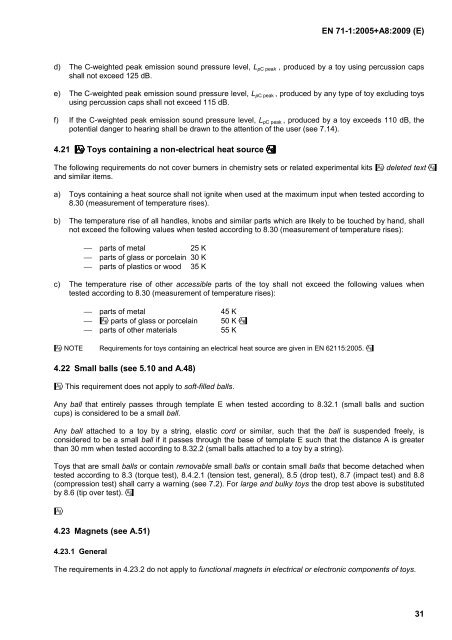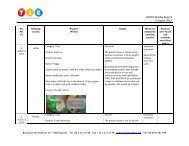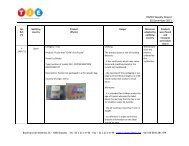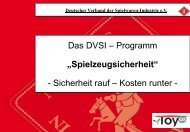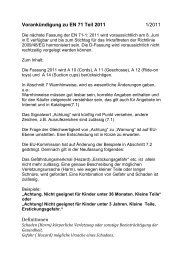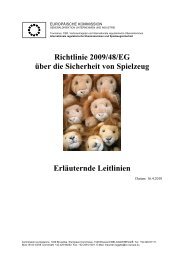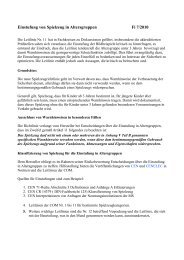Create successful ePaper yourself
Turn your PDF publications into a flip-book with our unique Google optimized e-Paper software.
<strong>EN</strong> <strong>71</strong>-1:<strong>2005+</strong><strong>A8</strong>:2009 (E)<br />
d) The C-weighted peak emission sound pressure level, LpC peak , produced by a toy using percussion caps<br />
shall not exceed 125 dB.<br />
e) The C-weighted peak emission sound pressure level, LpC peak , produced by any type of toy excluding toys<br />
using percussion caps shall not exceed 115 dB.<br />
f) If the C-weighted peak emission sound pressure level, LpC peak , produced by a toy exceeds 110 dB, the<br />
potential danger to hearing shall be drawn to the attention of the user (see 7.14).<br />
4.21 +Toys containing a non-electrical heat source,<br />
The following requirements do not cover burners in chemistry sets or related experimental kits +deleted text,<br />
and similar items.<br />
a) Toys containing a heat source shall not ignite when used at the maximum input when tested according to<br />
8.30 (measurement of temperature rises).<br />
b) The temperature rise of all handles, knobs and similar parts which are likely to be touched by hand, shall<br />
not exceed the following values when tested according to 8.30 (measurement of temperature rises):<br />
⎯ parts of metal 25 K<br />
⎯ parts of glass or porcelain 30 K<br />
⎯ parts of plastics or wood 35 K<br />
c) The temperature rise of other accessible parts of the toy shall not exceed the following values when<br />
tested according to 8.30 (measurement of temperature rises):<br />
⎯ parts of metal 45 K<br />
⎯ +parts of glass or porcelain 50 K,<br />
⎯ parts of other materials 55 K<br />
+NOTE Requirements for toys containing an electrical heat source are given in <strong>EN</strong> 62115:2005.,<br />
4.22 Small balls (see 5.10 and A.48)<br />
)This requirement does not apply to soft-filled balls.<br />
Any ball that entirely passes through template E when tested according to 8.32.1 (small balls and suction<br />
cups) is considered to be a small ball.<br />
Any ball attached to a toy by a string, elastic cord or similar, such that the ball is suspended freely, is<br />
considered to be a small ball if it passes through the base of template E such that the distance A is greater<br />
than 30 mm when tested according to 8.32.2 (small balls attached to a toy by a string).<br />
Toys that are small balls or contain removable small balls or contain small balls that become detached when<br />
tested according to 8.3 (torque test), 8.4.2.1 (tension test, general), 8.5 (drop test), 8.7 (impact test) and 8.8<br />
(compression test) shall carry a warning (see 7.2). For large and bulky toys the drop test above is substituted<br />
by 8.6 (tip over test).*<br />
/<br />
4.23 Magnets (see A.51)<br />
4.23.1 General<br />
The requirements in 4.23.2 do not apply to functional magnets in electrical or electronic components of toys.<br />
31


